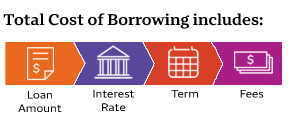When you consider taking out a loan, opening a line of credit, or getting a credit card, it’s important to understand all the costs involved. More than 40% of Americans report having more debt than they are comfortable with, according to the 2024 Wells Fargo Money Study.
What is your total cost of borrowing?
A big factor in how much money borrowers owe is the total cost of borrowing, which encompasses several expenses outside of your monthly payment that can make a big impact on your finances. Understanding these costs can help you make informed decisions and manage your money more effectively.
Your total cost of borrowing is the sum of all expenses associated with taking out a loan, including the principal amount, interest, and any other fees. A working understanding of these components helps you better predict the overall cost of a loan and avoid unexpected financial burdens. Here’s a closer look:

1. Loan amount
The loan amount is the initial sum of money you borrow. It’s also known as the principal. This amount directly influences the interest rate, terms, and potential fees you may pay. It’s important to decide precisely how much you need to borrow and to avoid borrowing too much. A higher loan amount might require a longer term to keep monthly payments manageable, which increases the amount you pay in interest and can increase the total cost of borrowing.
Tip
2. Interest rate/annual percentage rate (APR)
Lenders charge interest when you borrow. The rate you pay is based on factors such as the amount you borrow, your term, and your credit history. It’s typically expressed as a percentage. APR includes both the interest rate and any additional fees, averaged over the loan term – and it’s also expressed as a percentage. Comparing APRs across different lenders gives you a more comprehensive understanding of the total cost of your loan.
Interest rates may be fixed or variable. Fixed rates don’t change over the life of a loan. They offer stability, with consistent monthly payments that may make budgeting easier. Variable interest rates may increase or decrease over time depending on economic conditions. Changing rates can affect your monthly payments and the total cost of borrowing money.
Tip
3. Loan term
The loan term is the duration over which you repay the money you borrow. It affects both your monthly payment and the total interest paid. A longer term can lower monthly payments but can increase the total cost of borrowing as you pay interest over a long period of time. Consider the following hypothetical comparison:
- A $15,000 loan at a 7.75% APR with a 10-year term would have monthly payments or $180.02. The total cost of the loan, including interest and fees would be $21,602.40.
- The same loan with a five-year term would have $302.35 monthly payments, and the total cost of borrowing would be $18,141.00.
- Finally, the same loan with a three-year term would have $468.32 monthly payments and the total cost of borrowing would be $16,859.52.
Tip
4. Loan fees
Fees are typical of most loans, but can significantly affect the cost of borrowing money. Some common fees include:
- Origination fees for processing the loan application.
- Prepayment penalties for paying off the loan early.
- Annual fees for maintaining the account.
- Transfer fees for moving balances between accounts.

 Sign On
Sign On 
